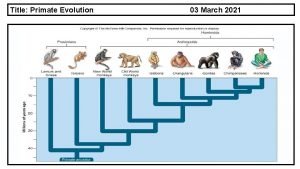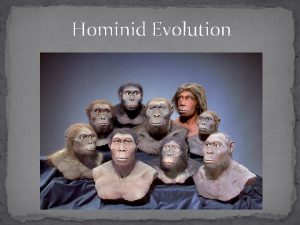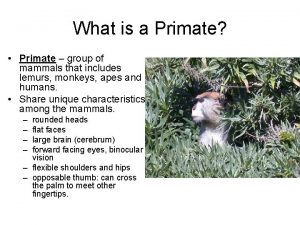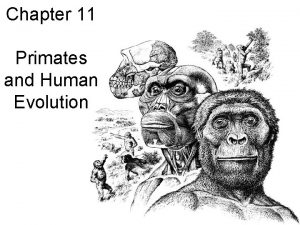Chapter 16 Primate Evolution What is a Primate













- Slides: 13

Chapter 16 Primate Evolution

What is a Primate? A group of mammals that include lemurs, monkeys, apes, & humans that evolved from a common ancestor

Characteristics of Primates Movable fingers & toes Flattened nails instead of claws Opposable thumb – Used for grasping and manipulating tools Color vision – Aids in depth perception Front-facing eyes (perceive depth) Rounded head with flattened face

More primate characteristics Flexible shoulder and hip joints Large Brain – Leads to diverse behaviors and social interactions Binocular vision – Perceive depth and gauge distances

Common Ancestry Humans are not descended from chimpanzees or modern apes, but they likely all descended from a primitive apelike ancestor. Evidence: structural and social similarities

Bipedalism One group of ancestors (hominoids) became bipedal (they walked on two feet). Why? – Maybe they had to leave the trees in search of food on the ground. These bipedal primates are called hominids—modern humans and their direct ancestors

Why was bipedalism beneficial? Increased speed Hands are free to feed and protect young Able to use tools

How do we know what ancient hominids were like? Paleoanthropologists study fossils of hominids to find out what they were like. Shape and arrangement of bones gives clues about how they lived.

Who were the first hominids? Australopithecines – Lived in Africa – Possessed both apelike & humanlike characteristics – “Lucy” was the first complete Australopithecine fossil found (3. 2 million yrs) – Small, apelike brain

A new genus Hominids with a large cranial (brain) capacity have been grouped into the genus Homo. Examples: – Homo erectus – Homo sapiens Evolved from Homo erectus

Sister species of Homo sapiens Neanderthals – Larger brains than modern humans – Shorter, stalkier – Lived in caves – Used tools – Spoken language – Thick bones, large faces – Existed at the same time as Homo sapiens

Early Homo sapiens Cro-magnons – Same height, skull structure, tooth structure, & brain size as modern humans – Tool-makers, artists (cave drawings) – Language

Modern Humans Originated in Africa 100, 000 -200, 000 years ago Inhabited Africa, Asia, & Europe before crossing a land bridge into N. America
 Chapter 16 section 1 primates study guide answers
Chapter 16 section 1 primates study guide answers Chapter 16 primate evolution
Chapter 16 primate evolution Primate evolution tree
Primate evolution tree The great whales
The great whales Evolution of primates
Evolution of primates Primates
Primates Is mexico city a primate city
Is mexico city a primate city Rank size rule
Rank size rule Is london a primate city
Is london a primate city Rank-size rule examples
Rank-size rule examples Purgatorius
Purgatorius What originally made istanbul a primate city
What originally made istanbul a primate city Primate city frq
Primate city frq Primate suite of traits
Primate suite of traits























